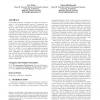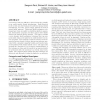113 search results - page 3 / 23 » Semantic Reduction of Thread Interleavings in Concurrent Pro... |
KBSE
2007
IEEE
13 years 11 months ago
2007
IEEE
Concurrent programs are difficult to debug and verify because of the nondeterministic nature of concurrent executions. A particular concurrency-related bug may only show up under ...
FM
2009
Springer
13 years 11 months ago
2009
Springer
Abstract: There is growing need to develop formal verification tools for Message Passing Interface (MPI) programs, to eliminate bugs such as deadlocks and local assertion violatio...
SIGSOFT
2010
ACM
13 years 2 months ago
2010
ACM
Concurrent programs are notoriously difficult to debug. We see two main reasons for this: 1) concurrency bugs are often difficult to reproduce, 2) traces of buggy concurrent execu...
ICSE
2010
IEEE-ACM
13 years 9 months ago
2010
IEEE-ACM
Concurrency fault are difficult to find because they usually occur under specific thread interleavings. Fault-detection tools in this area find data-access patterns among threa...
LICS
2000
IEEE
13 years 9 months ago
2000
IEEE
Concurrent ML is an extension of Standard ML with π-calculus-like primitives for multi-threaded programming. CML has a reduction semantics, but to date there has been no labelled...


